
14 minute read
Finding Her Happy
by JENNIFER KULYNYCH photography by RALPH DEFALCO
Henley Beall’s life could be a screenplay: talented young artist spends her days working as a barista and her nights sketching and painting. Using Instagram to promote her work, she hopes to beat the odds and make her name without an art school education. She’s not entirely sure how it will work out or whether she can actually turn her creativity into a viable career. Yet Beall is more than okay with that. “Art makes me happy,” she says, smiling, “and I’d rather struggle and still be happy.” Will she succeed? You can’t meet her and not hope that she does. At first glance, you might imagine
Advertisement
All-Seeing Eyes by Henley Beall. Pen and charcoal.

Curiosity by Henley Beall. Charcoal. Beall is just another twentysomething pulling shots behind the counter of Rise Up Coffee in Annapolis: jeans, baggy shirt, tousled hair, discrete tattoos. She’s a little bit guarded and studiously ironic. And she still lives at home with her parents, Kurt and Lila Beall, in Hillsmere. Named for a family friend, Beall is tall, with long dark hair. Her smile is incandescent, engaging, and transformative, making her hazel eyes glow and dissolving any wariness. Smiling, she has star power.
Talking about art, her own art in particular, makes Beall smile. She remembers being very young when her favorite aunt first taught her to draw butterflies. As a middle schooler, Beall studied at Wiley Bates Middle School’s performing and visual arts magnet program, where teachers Leo Hylan and Jean Orzech helped her develop her talents and taught her the artistic and digital imaging techniques she still uses today.
Beall’s experience at Annapolis High School was more complicated. She loved being part of a diverse public school community, and says she made close friends she would never have met in what she describes as the insular world of Annapolis’ private schools. Still, she chafed at the structure of high school AP art classes. She grew discouraged and gave up on art for a time, playing lacrosse instead, like her brother, Sam, age seventeen, and her sister, Malissa, age nineteen, both of whom still play lacrosse competitively. High school lacrosse was never Beall’s passion, though. “I wasn’t very good,” she says with a laugh, “but the team was fun.”
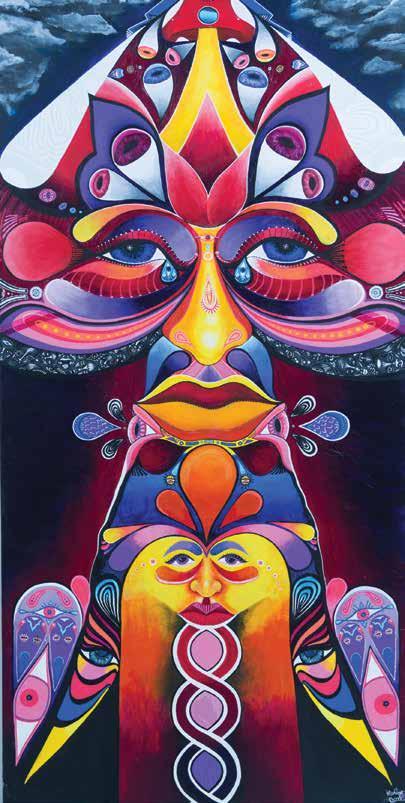
Introspection by Henley Beall. Digitized pen drawing.

After high school, Beall spent a semester at college in Florida, but soon returned to Annapolis. She enrolled in classes at Anne Arundel Community College and sought the advice of a family friend, noted Philadelphia cartoonist and illustrator Jim Hunt. Hunt advised her not to borrow money to go to art school but to start making and selling her art on her own terms, without shouldering the crushing burden of student loans.
Still, she needed a day job. Landing at Rise Up Coffee, Beall learned to make specialty drinks, mastering the art of tracing hearts and smiley faces in the froth of customers’ cappuccinos and
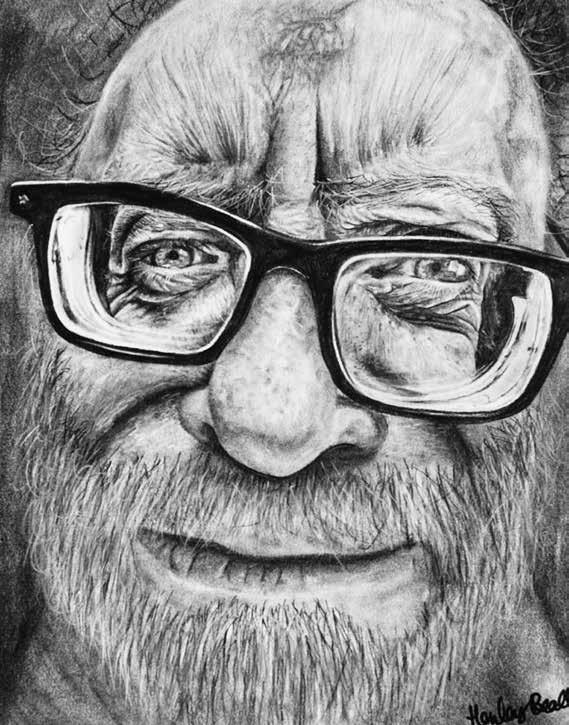
Confusion by Henley Beall. Charcoal.

Stress by Henley Beall. Charcoal.
getting hooked on a daily cortado—a caffeine blast comprising four shots of espresso and a splash of steamed milk.
Along the way, she found inspiration in the work of British photographer Lee Jeffries, who won critical acclaim for his series of stunning, high-contrast, extreme close-ups of homeless men and women. As a street artist who documents people living in the streetscape, he also uses photographic techniques to sharpen the contrast and emphasize the emotion in his subjects’ eyes. Seeing Jeffries’ raw, arresting images, Beall was moved to pick up charcoal and paper, hoping to create art that could speak equally powerfully. She began by using Jeffries’ work as a model and moved on to her own compositions, focusing on faces that convey strong emotion.
Beall’s other interest is psychedelic art, and some of her large, vivid works couldn’t be more different from her starkly detailed charcoal portraits. On days when Beall is more inclined to make bright, dynamic pieces, she likes to explore what she describes as the
Cicada by Henley Beall. Digitized pen and charcoal.
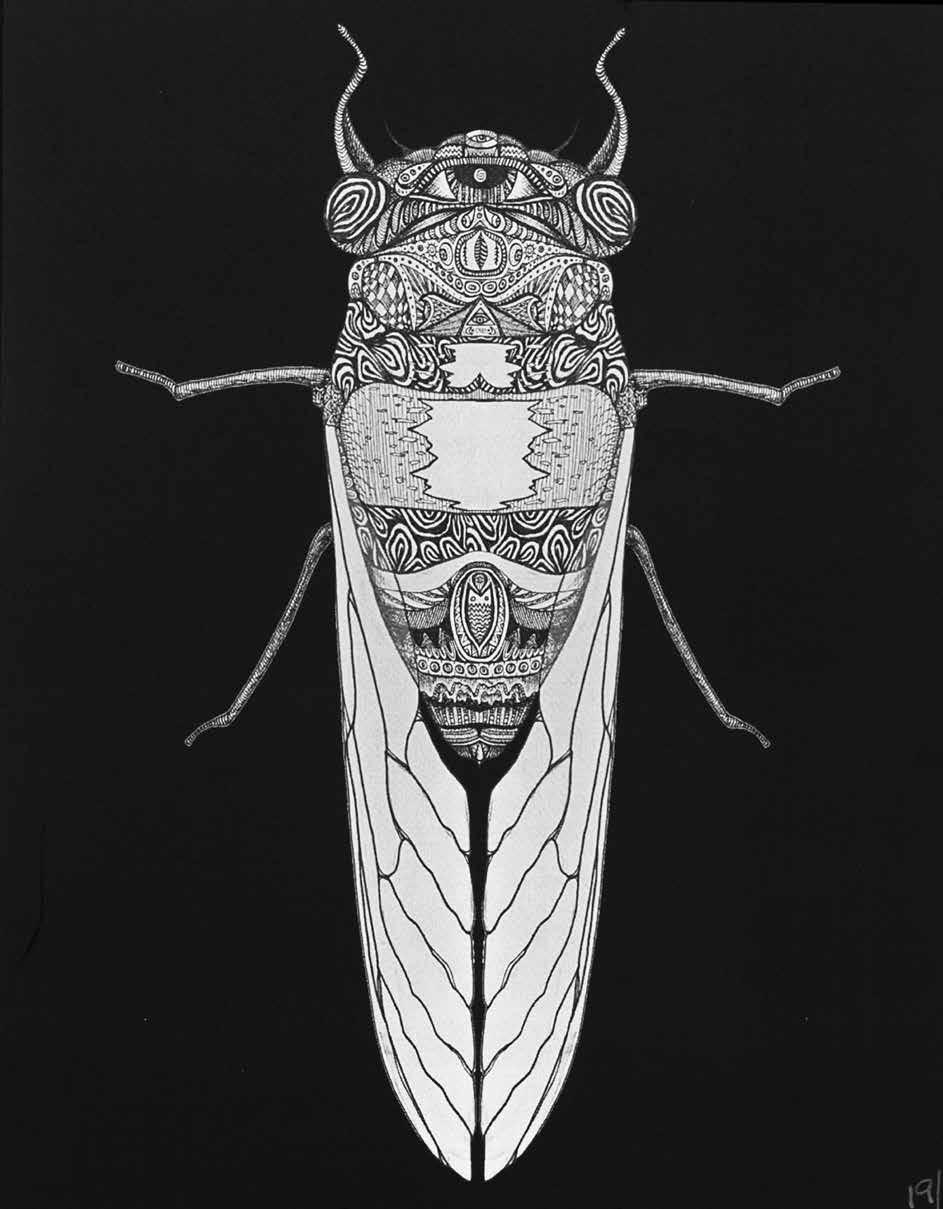

Ant by Henley Beall. Digitized pen and charcoal.
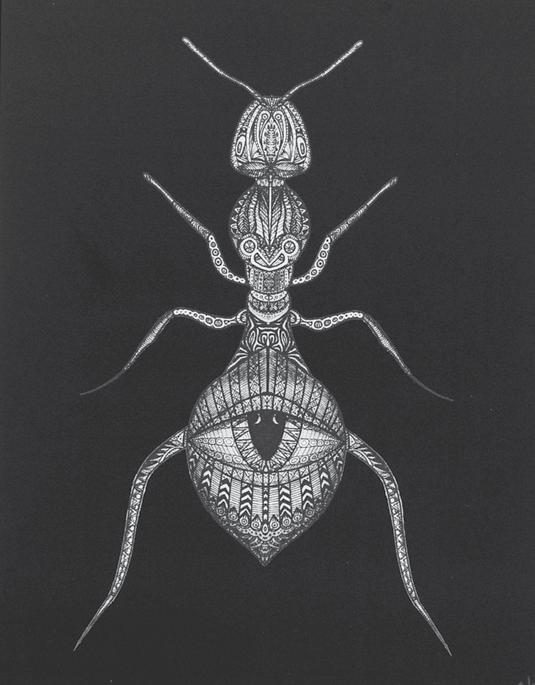

mathematics of geo-symmetry. Using acrylics and a large panel or paper, divided in half and gridded with a ruler, she allows the design to emerge on one half of the background, using the grid to mirror the shapes and colors on the other side. The result is part pop art, part Grateful Dead art print circa 1979.
Presently, Beall is building her portfolio and exhibiting her work. In September 2018, the restaurant Tsunami featured one of Beall’s first exhibits. She considered it an exciting success because she sold several pieces. She also maintains her presence on Instagram and developed a website on which she shows her work.
Beall has taken inspiration from Annapolis-based artist Jeff Huntington, and she aspires to have her art be as impactful as his someday. No matter how successful she may become, the native Annapolitan has strong ties to her community and its lively public art scene. “I can see myself staying here,” she says, “it’s a happy place to be.” █
For more information, visit www.henleybeall.com.
Artist Henley Beall. Photo courtesy of artist.
Get Some.

annapoliscanoeandkayak.com






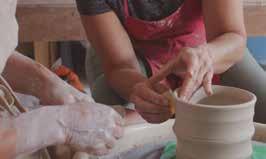

PASTS PRESENCES &
by GEOFFREY YOUNG photography by ALISON HARBAUGH
The novelist Lucia St. Clair Robson’s latest release, Devilish (2014), is a thriller about murder, romance, environmentalism, supernatural visitations, and the friendship between four formidable women. It takes place in Cliffs of the Severn, Arnold, which is also where Robson’s life in Pines on the Severn takes place. Sitting in her living room, she indicates through the picture window the homes of her characters’ real-life counterparts: “Faye lives there. I can throw a rock and hit it. Doc’s house is on the playground at the corner . . . This is Alice’s house.”
The importance of place is a constant in Robson’s work, though Devilish is a departure from the historical novels for which she is mostly known. Heretofore, she has transported readers to nineteenth century Texas, Tennessee, and Florida, to eighteenth century Japan, even to colonial Maryland. Given her life experience, itinerancy of time and locale is no surprise. Born in Baltimore and raised in Southern Florida, Robson lived in Venezuela during a stint in the
Author Lucia St. Clair Robson.
Peace Corps, Japan (“Just for the hell of it,” she says), Arizona, and South Carolina, before settling back in Maryland.
Robson got her start as a novelist on a lark, after meeting her future husband, the science fiction writer Brian Daley, at a writers convention in Baltimore in 1979. A librarian at the time, she happened to mention her interest in the life of Cynthia Ann Parker, who was kidnapped in 1836, at age nine, by Comanche Indians, and later married into their tribe. “Rescued” by Texas rangers 24 years later, Parker spent the rest of her days trying to return to her Comanche family. Daley’s editor, Owen Lock,
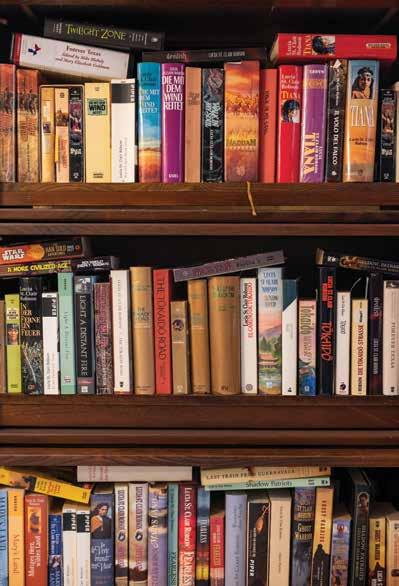
Robson’s collection of the 10 novels she has written and their different versions and translations published in other countries. suggested that Robson write a novel about Parker and send him a sample. “I told him not to be ridiculous,” she says, “I didn’t know how to write a book.” But she got started and eventually sent Lock six chapters. He called her with a wry acknowledgment: “I got your piece of trash,” he said, and subsequently forwarded the manuscript to an editor at Ballantine, who offered Robson a substantial advance on what would become Ride the Wind. It all seemed to happen by chance. “I didn’t dream of becoming a novelist,” she says. Today, she boasts two Spur Awards and a Lifetime Achievement award from Western Writers of America. The success of Ride the Wind, in 1982, set off a string of works involving American Indians, including Walk in My Soul (1985), about Tiana Rogers of the Cherokee, and Light a Distant Fire (1988), depicting the heroism of the Seminole tribe of Florida in the 1830s, a people that had fascinated her since learning about them in the fourth grade. “They held out against overwhelming odds,” she says. “They never surrendered. They never signed a peace treaty.”
Adversity is a common theme in Robson’s work. “Most of my books are about underdogs. I guess that’s why I write about women so much. In history, women are told to shut up and don’t bother people.” Robson feels that plumbing the lives of historical underdogs offers a salutary benefit to reader and writer alike. She says that such stories provide perspective. “When you know how bad it was, it helps you get through day to day.”
Robson keeps meticulous notes on her research and files them in an antique card catalog for quick reference.

But there is another sort of perspective at play in Robson’s work, something akin to possession or channeling, is necessary to successfully weaving fiction into the lives of real people. “In order to write about [historical figures], you really have to get into the time, the place, and hopefully their heads.” Her process begins with copious research — “I’ve run out of shelf space,” she says — and diligent organization. An old library card catalog, located in her woodpaneled home office, is stuffed with cards indexing the source of every fact contained in her novels. From this hard-earned perch of historical mastery, Robson’s imagination takes flight.
Perspective, then, becomes more than clarity gained by comparison. It represents experience by proxy, occurring in the mind, and it effects an almost magical transportation. “When you’re writing about [an event], you’re no longer a spectator. You’re a participator. These people become your friends.”
So, too, do their descendants. Robson’s empathetic portrayals of the life of native peoples led to her formal adoption into two tribes, which meant taking on tribal names. To the Comanches, she is Dek Wa Wop, or “one who speaks for others.” To the Cherokees, she is White Hawk.
you got those stories.’ I said, ‘Well, I either read them or I made them up.’ She said, ‘No, those are stories only the family knows.’” Little Dove went on to describe the family patriarch, known as Uncle, who kept by his bedside a Bible and a thoroughly marked-up copy of Walk in my Soul. When Little Dove told Uncle the elders wanted to adopt Robson, he replied, “You can if you want, but she’s been with the family a long time.”
Robson folds her long frame into a low living room chair, Such acceptance has been primary for Robson. “[After Ride the Wind came out], I wasn’t worried about what the [literary] critics would say. I was worried about what the Comanches would say.”
In the case of the Cherokee descendants of Tiana Rogers, the family was impressed by more than just the literary merits of Walk in my Soul. “I got a phone call from someone called Little Dove after the book came out. She said, ‘The family wants to know where reflecting upon her stories. “I’m not spooky. I’m not religious. But there are unexplained things that happen. Some connections get made.”
A particular connection came in 1996, not long after her husband, Brian, had succumbed to pancreatic cancer. A close friend called to tell her Brian’s spirit had visited him, “big as life.” Soon thereafter, Robson was involved in a car accident on Route 50. Once home, “I was kind of shaken. I was lying on the couch. And I just felt

Robson researches for her next novel with the working title Camel Corps. She studies maps and books written about the region and stories from the past.

this overwhelming sense of love . . . It was the most intense thing I’ve ever felt. And I guess it was Brian.”
She looks out the window from her low chair, pensive, amused. “A lot of these houses have ghost stories.” Robson calls Devilish her most autobiographical novel. She began it soon after Brian’s passing, but set it aside. “It was too whiny, too selfpitying.” Molded by time’s softening hand, the novel is fun, inventive, strange, and rich with intricate detail. Supernatural visitations mostly take the form of incubi—raunchy sex demons—but the women of the novel hold their lost loves vividly in mind, as Robson does hers, and feel their presence, big as life. Devilish may represent a departure for Robson the historical novelist, but it continues a creative process emphasizing experience borne of imaginative flights and an orientation toward unseen worlds, whether they be epochs long past or strange occurrences right next door. Up next, Robson aims to cinch two strands of her interest: she’s working on a novel about Jefferson Davis’ Camel Corps experiment in the pre-Civil War southwest.
“Maybe a haunted guest house kind of thing,” she hints, a sparkle in her eye. █
For more information, visit www.luciastclairrobson.com.
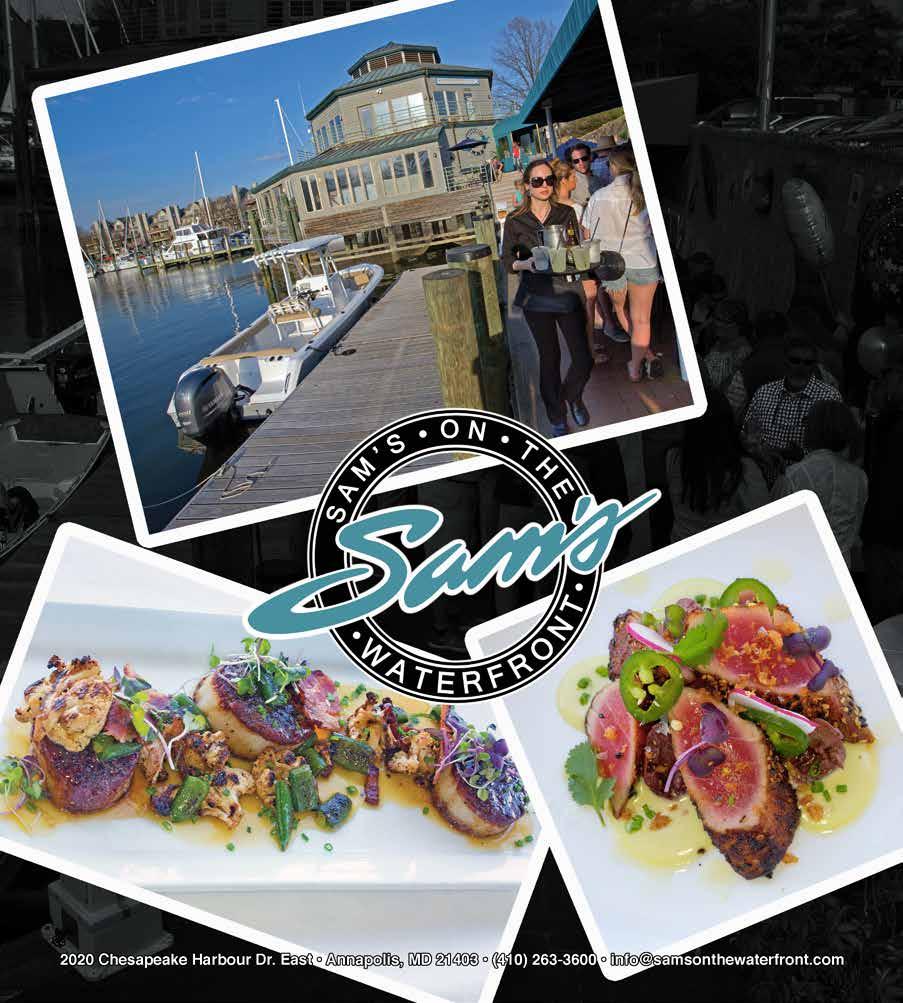
For those who seek an exceptional life



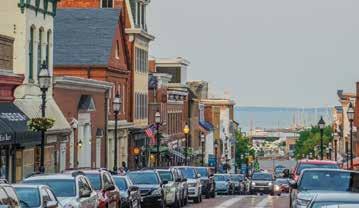
Deeply rooted in the Annapolis community, Brad is a third generation Annapolitian who combines his local expertise with the worldwide recognition of the iconic Sotheby’s brand. With more than $200 million in Annapolis home sales and 125 waterfront properties sold, Brad delivers the highest standard of service and exclusive access to highly qualified global clientele.
For those ready for what’s next, make your move with Brad Kappel.
Brad Kappel m +1 410 279 9476, bkappel@ttrsir.com, BradKappel.com Annapolis Brokerage, 209 Main Street, o +1 410 280 5600
by MARLEY CRANK photography by KAITLYN MCQUAID Main Focus
Asmall group of friends walk through the doors of Main & Market for a weekend dinner out. They come upon a crowded dining room filled with the smiling faces of families and friends enjoying their meals. The hostess welcomes them into the café, informing them that it will be a bit of a wait. Comforting smells of home cooking waft through the air, and the tantalizing cakes and piles of pastries in the case across the room create a sense of homeyness. The group eyes each enticing dish that is being delivered around them before the decision seems to make itself: “Put us down for a party of three, please!”
The enterprise that has become Main & Market was originally named Main Ingredient. It was born out of Garry’s Grill, a restaurant in Severna Park, when it decided to broaden its horizons to catering. Michelle O’Brien brought the concept to life by in 1993, and from the get-go she aimed to provide carefully curated and high-quality catering experiences to a broad clientele.
The company quickly outgrew its Severna Park roots and upgraded to a bigger space to accommodate more catering jobs. In 1997, Main Ingredient moved to its current location at 914 Bay Ridge Road in Annapolis. At the time, that area was not home to many food service providers, but the location proved to be ideal, especially as the company became the exclusive caterer to the Blue Heron Room at Quiet Waters Park, just down the road.
Main Ingredient flourished and soon integrated a café and bakery along with its catering services, providing to-go gourmet foods, desserts, and drinks—a service ahead of its time—which captivated the attention of the local community. A year after the Annapolis location opened, the relationship between Main Ingredient and Garry’s Grill dissolved, and the café matured to include the option to eat in. This offered customers the
A table display is set to showcase the catering services of Main & Market Catering in Annapolis.








